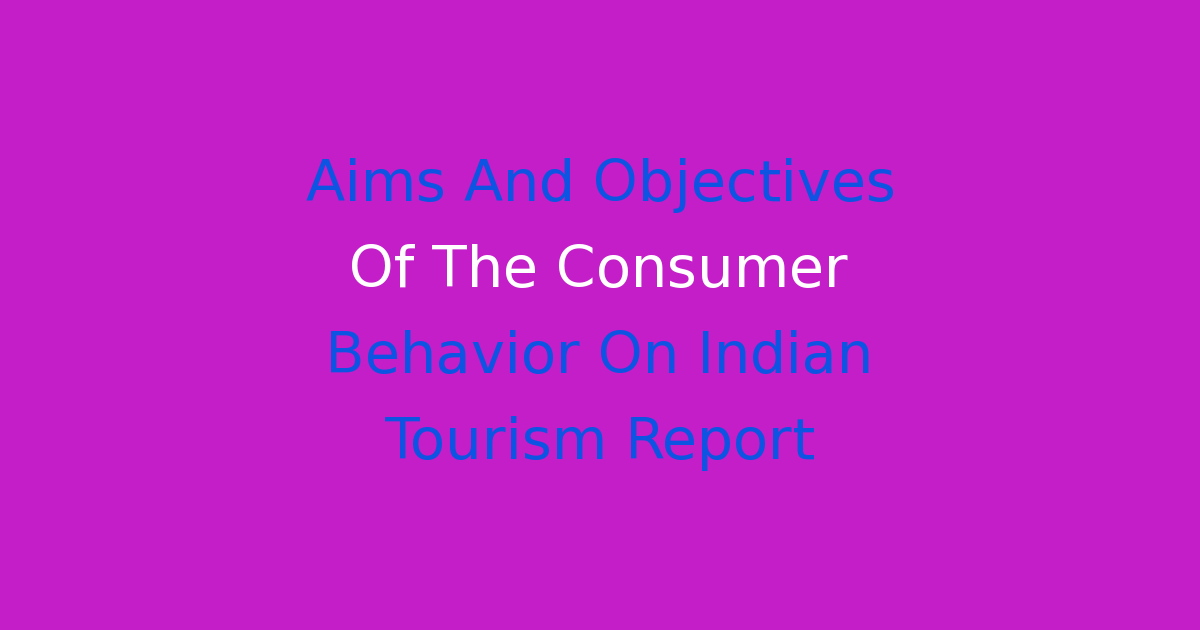The goal and purpose of the consumer behavior in Indian tourism report is to analyze and understand the behavior of tourists in India and the factors influencing their decision-making process, with the ultimate aim of providing insights and recommendations for improving the overall tourism industry in the country.
Consumer Behavior on Indian Tourism
Introduction
India is a land of diverse cultures, traditions, and landscapes, making it a popular tourist destination for travelers from all around the world. With the rise of globalization and easier access to information through the internet, the tourism industry in India has witnessed significant growth over the past few years. As a result, understanding consumer behavior in the context of Indian tourism has become a crucial aspect for businesses operating in this sector.
Problem Statement
The aim of this academic project report is to analyze the consumer behavior patterns of tourists visiting India. By understanding the preferences, motivations, and decision-making processes of tourists, businesses in the tourism industry can tailor their marketing strategies and offerings to better meet the needs and expectations of their target audience. This, in turn, can lead to increased customer satisfaction, loyalty, and ultimately, higher revenues.
Existing System
Currently, most businesses in the Indian tourism industry rely on traditional marketing techniques, such as print advertisements, brochures, and word-of-mouth referrals, to attract customers. While these methods have been effective in the past, they may not be sufficient in today’s digital age where consumers are constantly exposed to a barrage of information and options. Furthermore, the lack of real-time data and consumer insights makes it challenging for businesses to adapt quickly to changing market trends and consumer preferences.
Disadvantages
The existing system of marketing and customer engagement in the Indian tourism industry has several disadvantages. Firstly, businesses may struggle to reach and connect with their target audience effectively, leading to lower customer acquisition and retention rates. Secondly, without access to comprehensive consumer behavior data, businesses may find it difficult to understand why certain marketing campaigns or products are successful while others fail. Finally, the lack of personalized and targeted marketing initiatives can result in missed opportunities for upselling, cross-selling, and customer relationship-building.
Proposed System
In light of these challenges, the proposed system for consumer behavior analysis in the Indian tourism industry involves the collection, analysis, and interpretation of data from various sources, such as online surveys, social media platforms, customer reviews, and website traffic. By leveraging advanced analytics techniques and technologies, businesses can gain valuable insights into consumer preferences, behaviors, and trends. This information can then be used to create targeted marketing campaigns, personalized offers, and tailored experiences for different segments of the target audience.
Advantages
The proposed system offers several advantages for businesses in the Indian tourism industry. Firstly, it enables businesses to gain a deeper understanding of their target audience, allowing them to create more relevant and engaging marketing campaigns. Secondly, by identifying patterns and trends in consumer behavior, businesses can anticipate and respond to changing market dynamics proactively. Finally, the use of data-driven insights can help businesses optimize their operations, increase efficiency, and maximize ROI on marketing investments.
Features
Some key features of the proposed system for consumer behavior analysis in Indian tourism include:
1. Data collection from multiple sources: The system will gather data from online and offline channels to ensure a comprehensive view of consumer behavior.
2. Advanced analytics tools: Businesses can leverage machine learning algorithms, predictive modeling, and other analytical techniques to extract meaningful insights from the data.
3. Real-time monitoring and reporting: The system will provide real-time dashboards and reports to track key performance indicators and make data-driven decisions quickly.
4. Personalization and customization: Businesses can create personalized marketing campaigns, offers, and experiences based on individual consumer preferences and behaviors.
5. Cross-channel integration: The system will facilitate seamless communication and coordination across different marketing channels, such as social media, email, and mobile apps.
Conclusion
In conclusion, the consumer behavior on Indian tourism project aims to address the challenges faced by businesses in understanding and catering to the needs of their target audience effectively. By adopting a data-driven approach to consumer behavior analysis, businesses can unlock new opportunities for growth, innovation, and competitive advantage in the dynamic and fast-paced tourism industry. This project not only offers theoretical insights into consumer behavior but also provides practical recommendations for businesses looking to thrive in the digital age.

